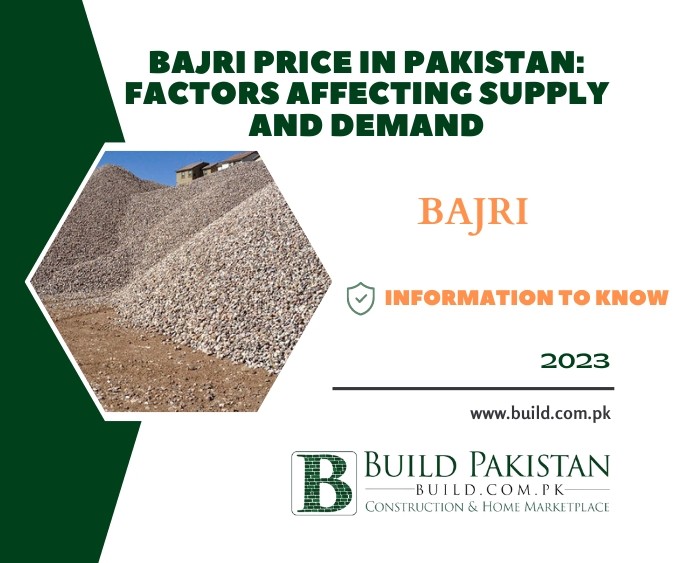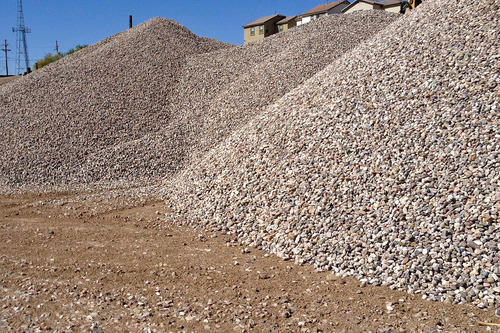Bajri Price in Pakistan: Factors Affecting Supply and Demand

Introduction:
Bajri, also known as gravel or crushed stone,
is an essential construction material used in various infrastructure and
building projects. Its durability, strength, and versatility make it a popular
choice for road construction, concrete production, and landscaping purposes. In
this blog, we will delve into the factors influencing the price of bajri in
Pakistan, including supply and demand dynamics, extraction and transportation
costs, government regulations, and market trends Understanding these factors
will help individuals and businesses make informed decisions regarding bajri
procurement and budgeting for construction projects.

Supply and Demand Dynamics
The price of bajri in Pakistan is
influenced by the interplay between supply and demand factors. The availability
of bajri depends on the presence of suitable deposits in specific regions and
the capacity of extraction operations. Factors affecting supply include:
Geological Factors:
The geological composition of an area
determines the presence and quality of bajri deposits. Areas with abundant and
easily accessible reserves tend to have a higher supply and potentially lower
prices.
Extraction Operations:
The efficiency and scale of extraction operations impact the quantity of bajri available in the market. Technological advancements in mining and crushing techniques can increase production capacity and affect prices.

What are the uses of Bajri
Bajri, or gravel/crushed stone, has various uses in
construction and landscaping. Some of the common applications of bajri include:
Road Construction:
Bajri is widely used as a base material in
road construction. It provides stability, strength, and drainage properties to
the road surface, ensuring durability and longevity.
Concrete Production:
Bajri is a crucial component in the
production of concrete. It is mixed with cement, sand, and water to create the
concrete mixture. Bajri adds strength and stability to the concrete, making it
suitable for various construction purposes.
Landscaping:
Bajri is commonly used in landscaping projects.
It can be used to create pathways, driveways, and patios, providing a stable
and visually appealing surface. Bajri can also be used for decorative purposes
in gardens, creating a natural and rustic look.
Building Foundations:
Bajri is often used as a base material
for building foundations. It provides a stable and compacted layer that helps
distribute the weight of the structure evenly and prevents settling.
Drainage Systems:
Bajri is used in the construction of
drainage systems, including French drains, trench drains, and septic systems.
It allows for proper water drainage and helps prevent waterlogging and
flooding.
Factors influencing the need for bajri include
Construction Activities:
The construction industry is a
significant driver of bajri demand. Infrastructure development, housing
projects, and commercial construction activities contribute to the demand for
bajri.
Urbanization and Population Growth:
Rapid urbanization and
population growth lead to increased demand for housing, roads, and
infrastructure, driving the need for bajri.
Government Projects:
Government-led initiatives, such as road
construction, dams, and public infrastructure projects, contribute to the
demand for bajri.
Extraction and Transportation Costs
The cost of extracting
bajri and transporting it to the market also affects its price. Factors
influencing extraction and transportation costs include:
Mining and Crushing Techniques:
The efficiency and technology
used in the mining and crushing processes impact the overall cost of
production Advanced machinery and techniques can reduce costs and subsequently
affect prices.
Distance and Accessibility:
The distance between the
extraction sites and the market plays a role in transportation costs. Remote
areas with limited accessibility may have higher transportation expenses, which
can increase the price of bajri.
Government Regulations and Policies
Government regulations and policies can significantly impact the bajri market and its pricing. Some relevant factors include:
Environmental Regulations:
Environmental regulations
governing mining operations, such as environmental impact assessments and
reclamation requirements, can increase operational costs and potentially affect
the price of bajri.
Licensing and Permits:
The licensing and permitting process
for bajri extraction can influence the number of suppliers in the market. Restrictions
or delays in obtaining licenses may limit supply and potentially raise prices.

Market Trends
Market trends and fluctuations in the
construction industry can also influence the price of bajri. Factors to
consider include:
Economic Conditions:
Economic conditions, including
inflation, currency fluctuations, and overall market demand, can impact the
pricing of construction materials, including bajri.
Seasonal Demand:
Bajri prices may vary seasonally due to
changes in construction activity. Increased demand during peak construction
seasons can affect prices.
Conclusion:
The price of bajri in Pakistan is influenced by a
combination of factors, including supply and demand dynamics, extraction and
transportation costs, government regulations, and market trends. Understanding
these factors is crucial for individuals and businesses involved in
construction projects to make informed decisions regarding bajri procurement
and budgeting. By monitoring market conditions, assessing project requirements,
and considering cost-effective sourcing options stakeholders can navigate the
bajri market effectively and optimize their construction endeavors.









